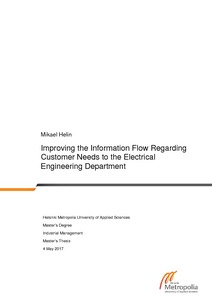Improving the Information Flow Regarding Customer Needs to the Electrical Engineering Department
Helin, Mikael (2017)
Helin, Mikael
Metropolia Ammattikorkeakoulu
2017
All rights reserved
Julkaisun pysyvä osoite on
https://urn.fi/URN:NBN:fi:amk-201705178741
https://urn.fi/URN:NBN:fi:amk-201705178741
Tiivistelmä
This Thesis focuses on improving the information flow regarding customer needs from Marine segments to the Electrical Engineering department. The case company provides its services for Land and Marine applications all over the world – either as turnkey or instrument deliveries. End-customer delivery projects tend to vary significantly from each other due to local regulations and customer specifications. Therefore, the case company needs to deliver a unique system for each End-customer individually.
End-customer delivery projects for Marine segment call for a comprehensive understanding of customer needs by all the internal stakeholders in the case company. However, the communication distance from the customer via Sales and other functions is quite long and the detailed needs do not always come through the Electrical Engineering department or the message might be misinterpreted somewhere in the communication chain.
The approach to conducting research in this Thesis was an Action research with a combination of mainly two different research strategies. These two strategies are qualitative research and field study method. Data was collected within the case company through interviews, workshops and feedback. This study was conducted by analyzing the current state first, which guided the choice for relevant literature to help for proposing logical improvements.
In the current state analysis, findings suggested that the ease of communication is a key strength, whereas lack of communication across organizational borders, obstructions in information flow and insufficient collaboration structures were identified as key weaknesses. By the guidance of relevant literature and the help of stakeholder suggestions, several specific improvements were proposed to increase communication across organizational borders, enable transparency in information flow and improve cross-organizational collaboration.
The departmental inequality in knowledge of customer needs is typically a result of poor internal communication. If the internal information flow regarding customer needs is not sufficient enough, eventually the customers might be dissatisfied with their products or services. Inadequate internal information flow is recognized throughout the case company, and tangible improvements suggested in this Thesis are expected to be taken into use.
End-customer delivery projects for Marine segment call for a comprehensive understanding of customer needs by all the internal stakeholders in the case company. However, the communication distance from the customer via Sales and other functions is quite long and the detailed needs do not always come through the Electrical Engineering department or the message might be misinterpreted somewhere in the communication chain.
The approach to conducting research in this Thesis was an Action research with a combination of mainly two different research strategies. These two strategies are qualitative research and field study method. Data was collected within the case company through interviews, workshops and feedback. This study was conducted by analyzing the current state first, which guided the choice for relevant literature to help for proposing logical improvements.
In the current state analysis, findings suggested that the ease of communication is a key strength, whereas lack of communication across organizational borders, obstructions in information flow and insufficient collaboration structures were identified as key weaknesses. By the guidance of relevant literature and the help of stakeholder suggestions, several specific improvements were proposed to increase communication across organizational borders, enable transparency in information flow and improve cross-organizational collaboration.
The departmental inequality in knowledge of customer needs is typically a result of poor internal communication. If the internal information flow regarding customer needs is not sufficient enough, eventually the customers might be dissatisfied with their products or services. Inadequate internal information flow is recognized throughout the case company, and tangible improvements suggested in this Thesis are expected to be taken into use.
